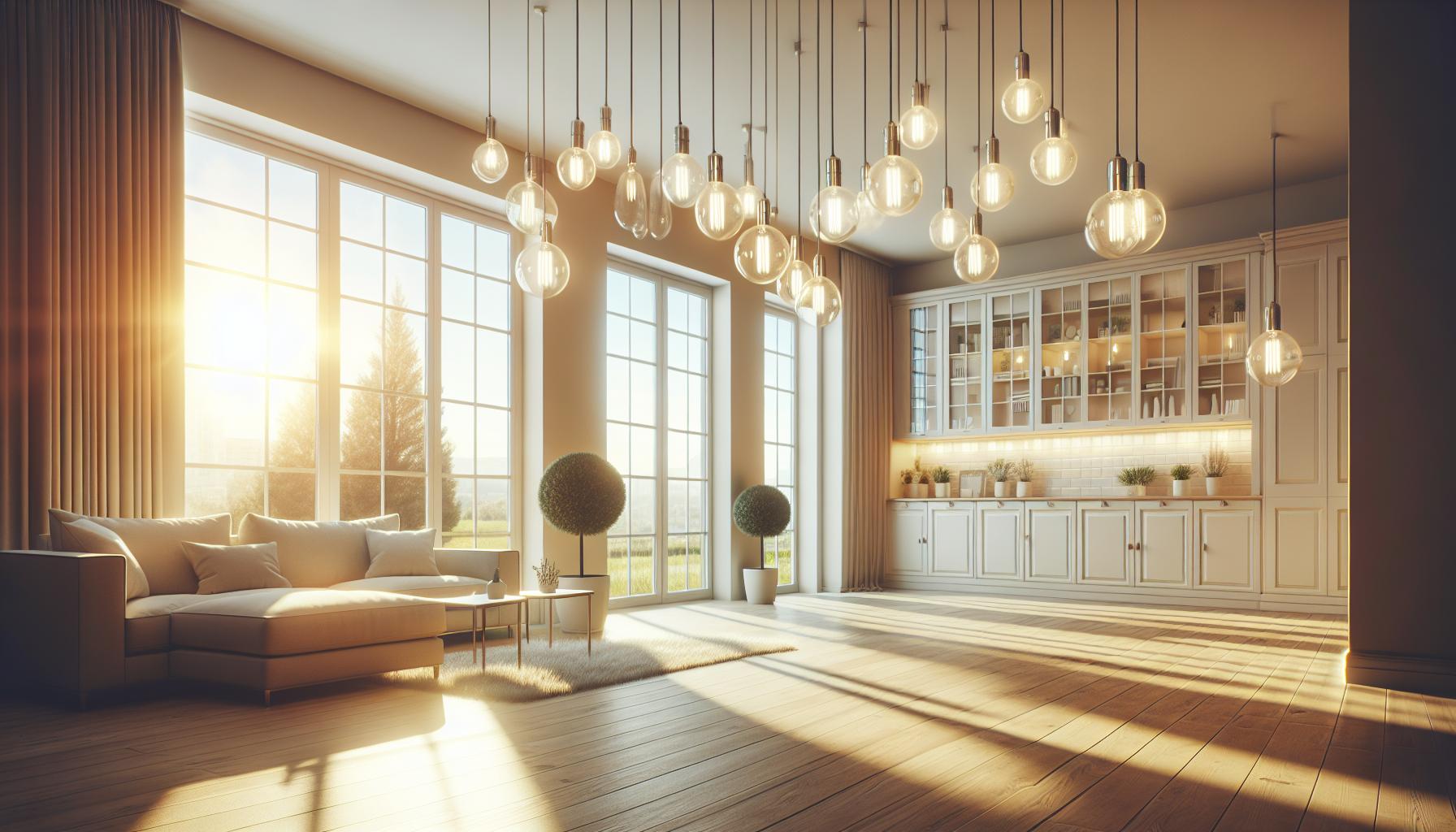Ever found yourself longing for the warm embrace of sunlight on a dreary day indoors? You’re not alone. The quest for light bulbs that mimic the natural glow of the sun has been a game-changer for indoor spaces.
It turns out, the right bulb can transform your room from a dim cave to a bright, airy sanctuary. But with so many options, how do you find the one that truly brings the outdoors in?
What is natural light?
You’ve probably basked in the warmth of a sunny day and felt its energizing effect. Natural light is that full spectrum of sunlight that you enjoy outdoors. It’s dynamic and changes from dawn to dusk, offering a range of color temperatures, from the warm hues at sunrise to the bright, blue-white light of midday, and then back to the warmth of sunset.
This type of light is vital for your well-being and mood. Exposure to natural light can increase your vitamin D storage, enhance your mood, and regulate your circadian rhythm — which impacts your sleep-wake patterns. So when you’re looking for the perfect bulb, you’re essentially trying to recreate this effect indoors.
But what makes a light bulb’s output feel “natural”? It’s all about the color temperature and Color Rendering Index (CRI). Color temperature, measured in Kelvin (K), describes the light appearance. Bulbs with a color temperature of about 5000K to 6500K mimic noon daylight. Meanwhile, CRI measures the ability of a light source to reveal the colors of various objects faithfully in comparison with a natural light source. A higher CRI, closer to 100, indicates that the light source will make colors look true and vibrant, just as the sun would.
The Sun’s Influence on Light Bulb Technology
Manufacturers have developed bulbs that aim to closely emulate the light emitted by the sun. They’ve refined technologies, such as LED and Compact Fluorescent Lights (CFLs), to not only match the spectrum of sunlight but also its clarity and intensity. The latest bulbs even adjust throughout the day, providing cooler tones during the morning to boost alertness and warmer tones as the evening approaches to help you unwind.
Given your snap for DIY projects and your keen eye for design, understanding natural light nuances can help you craft spaces that feel more open, welcoming, and connected to the outdoors. It’s like harnessing the best part of a sunny stroll and channeling it into your home, which might just be the touch that transforms a room from simply four walls to a living, breathing space.
The importance of natural light in indoor spaces
Natural light does more than just brighten up a room—it plays a crucial role in your well-being. Basking in the ambiance of sunlight can boost your mood, enhance productivity, and even improve your health. Think about how a dose of sunshine lifts your spirits; that’s the magic indoor spaces need to capture.
Indoor lighting should do more than just make it possible for you to see. It’s about creating an environment where you thrive. Natural light influences circadian rhythms, the natural sleep-wake cycles that dictate your energy levels throughout the day. Good lighting mimics these rhythms, providing cool, energizing light in the morning and warm, relaxing light as the evening draws in.
When you’re working on your latest DIY project or redecorating your home, imagine how different paints, fabrics, and materials look under the midday sun. That’s the kind of accuracy you’re aiming for with lighting. High CRI light bulbs can make colors pop and textures come to life, just like they would in natural daylight. This not only impacts design considerations but can influence how comfortable you feel in your space.
But it’s not just about aesthetics. The right lighting can also reduce eye strain and fatigue, making your home not only beautiful but also more functional. Whether you’re reading the fine print on a label or concentrating on intricate handiwork, mimicry of natural light ensures you have optimal visibility without unnecessary strain.
Remember, it’s not just about the bulbs you choose; placement plays a key role too. Strategically position lamps and fixtures to eliminate shadows and replicate how sunlight fills a room. Play around with different angles and intensities to find that sweet spot that closely resembles the warmth and clarity of the sun’s rays. This thoughtful approach can transform your living space into a seamless blend of form and function, where every corner is kissed by light that whispers of the great outdoors.
Understanding the different types of light bulbs
« Where Is Light Bulb in Fridge? Quick Guide to Find & Fix It
What Light Bulb Is the Brightest? The Ultimate Lumen Guide Revealed »
When you’re on the hunt to replicate the sun’s natural glow, knowing your options is crucial. Light bulbs come in different shapes, sizes, and, more importantly, light qualities. These differences can make or break the ambiance of a room.
Incandescent Bulbs: The Old Standard
You may remember the classic incandescent bulb—the one that defined home lighting for years. While not the most energy-efficient, they have a color rendering index (CRI) of about 100, meaning they produce a full spectrum of light colors similar to natural light. However, due to energy standards, these bulbs are phasing out, urging you to consider alternatives.
Halogen Bulbs: Crisp and Bright
Halogen bulbs are an offshoot of the incandescent family. They provide a clean, white light and rank higher in energy efficiency but still fall short when compared to LED and fluorescent options. These bulbs bring out the true colors in your space, offering a quality of light close to daylight.
Compact Fluorescent Lamps (CFLs): The Energy Savers
Turning to CFLs, you’re looking at an energy-saving bulb that lasts longer than incandescents. The light can sometimes venture to the cooler side, which might not be as cozy as the warm light you’re after. Still, some CFLs are designed to mimic natural light—you just need to check the packaging for terms like “daylight” or “natural light.”
| Type | CRI Rating | Energy Efficiency | Color Temperature |
|---|---|---|---|
| Incandescent | 100 | Low | Warm white |
| Halogen | ~100 | Moderate | Cool white |
| CFL | 80 – 90 | High | Cool to warm |
LED Bulbs: The Game Changers
Finally, LED bulbs are the new go-to for lighting aficionados. Not only do they save energy supremely, but they also have a span that outlasts all others. LEDs can offer a spectrum akin to daylight, and with advanced technology, you can even adjust color temperatures to mirror the sun’s patterns—cool light during the day and warm light at night.
What to look for in light bulbs that mimic natural light
When you’re hunting for the perfect light bulb to bring that outdoor feel inside, there are a handful of key factors to consider. Your goal? To find a bulb that closely resembles the sun’s natural spectrum.
Color Temperature is at the heart of this quest. Measured in Kelvins (K), this indicator tells you how warm or cool the light from a bulb will appear. Natural sunlight during midday typically hovers around 5000K to 6500K, so you’ll want a bulb that matches this range to achieve a daylight effect in your space.
Next up, don’t overlook the Color Rendering Index (CRI). This value, on a scale from 0 to 100, reflects the accuracy with which a light bulb renders colors compared to daylight. For a truly natural feel, aim for bulbs with a CRI above 90. They’ll make the colors in your home pop just like they do under the big blue sky.
It’s also smart to consider Lumen Output. Essentially, this is a measure of brightness, with higher numbers indicating brighter light. You’ll need to balance brightness with the size and use of your room to find your sweet spot. Here’s a quick guide:
| Room Type | Suggested Lumen Range |
|---|---|
| Kitchen | 5000 – 10000 |
| Living Room | 1500 – 3000 |
| Bedroom | 1000 – 2000 |
| Bathroom | 4000 – 8000 |
Remember that bulbs with high efficiency ratings save you money on energy bills, so LED bulbs are often your best bet. They’re champions of both high CRI and appropriate color temperatures, all while keeping those energy costs down.
Your DIY projects and passion for lighting deserve the best. So, when you’re browsing the aisles or scrolling online, keep these factors in mind. The right bulb not only illuminates your space but also enhances how you feel in it. With a dash of knowledge and an eye for quality, you’ll make light choice look like a bright idea.
Popular brands and models of natural light mimicking bulbs
When you’re on the hunt for the perfect natural light experience indoors, knowing which brands and models stand out can save you time and guesswork. You’ll find a handful of leading brands that have done an impressive job at mimicking that sunny glow you’re after.
Philips is a name you’ll encounter often. The Philips Hue White Ambiance collection is particularly noteworthy, offering a range of color temperatures that easily adjust from warm to cool light, replicating the feel of natural daylight. These smart bulbs do more than just shine; they can sync with your daily routines and are controllable via an app, adding convenience to quality.
Another standout brand is GE Lighting. Their GE Reveal bulbs are engineered with a high CRI and exceptional color contrast, revealing the vivid colors and patterns of your home as though bathed in natural light. It’s an easy favorite for your DIY projects that demand attention to detail.
Don’t overlook Cree Lighting for a durable option. Cree’s LED bulbs often boast a high CRI and impressive lifespan, with options like the Cree TW Series LED providing consistent illumination that’s akin to natural daylight. These robust bulbs are a smart choice for areas in your home that require a lot of light without frequent replacements.
Soraa also makes the cut, particularly for those of you who want state-of-the-art lighting technology. Soraa’s bulbs utilize LED technology with a unique violet chip, offering full-spectrum lighting that makes the room’s colors pop.
- Philips: Hue White Ambiance
- GE Lighting: Reveal
- Cree Lighting: TW Series LED
- Soraa: Full Spectrum LED
Remember, the key is to choose bulbs with specifications that align with the principles of color temperature, CRI, and lumen output covered earlier. The right bulb transforms your space, taking it from dull to delightful with just a twist and a click. Keep your spaces well-lit and true-to-life with one of these top-notch contenders.
Conclusion
You’ve got the scoop on the best light bulbs to bring the brilliance of natural light into your space. Whether you’re leaning towards the versatility of Philips Hue, the color accuracy of GE Reveal, or the innovative technology behind Cree or Soraa, you’re well-equipped to make an informed choice. Remember, it’s all about finding the right balance of color temperature, CRI, and brightness to suit your needs. Go ahead and transform your home into a haven of natural light—it’s just a bulb change away!
Frequently Asked Questions
What are the best light bulb brands that mimic natural light?
Philips Hue White Ambiance collection, GE Reveal, Cree Lighting, and Soraa are popular brands for light bulbs that mimic natural light, each offering unique features to enhance color temperature and CRI for a more natural atmosphere.
Can Philips Hue White Ambiance bulbs be controlled remotely?
Yes, Philips Hue White Ambiance bulbs can be controlled via a smartphone app, allowing for adjustments in color temperature to suit different needs and times of the day.
What are the characteristics of GE Reveal light bulbs?
GE Reveal light bulbs are known for their high Color Rendering Index (CRI) and ability to enhance color contrast, making them ideal for spaces where accurate color perception is important.
How durable are Cree Lighting LED bulbs?
Cree Lighting LED bulbs are recognized for their durability, high CRI, and extended lifespan, making them a cost-effective and reliable lighting solution.
What makes Soraa bulbs different from other LEDs?
Soraa bulbs are unique because they use a violet chip in their LED technology, providing full-spectrum lighting that closely resembles natural daylight.
What factors should be considered when choosing light bulbs that mimic natural light?
When selecting light bulbs that mimic natural light, consider bulbs that offer the right balance of color temperature, Color Rendering Index (CRI), and lumen output to meet the intended use and desired ambiance.





